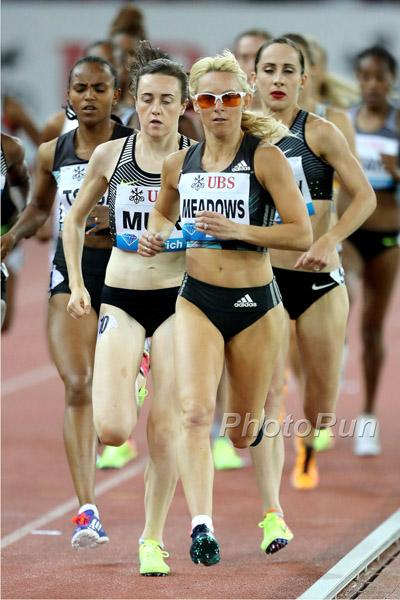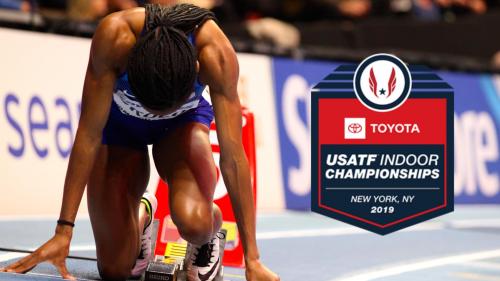 Jenny Meadows, photo by PhotoRun.net
Jenny Meadows, photo by PhotoRun.net
Stuart Weir sent me this interview a few months ago. In Karlsruhe, I had the absolute pleasure of meeting Jenny Meadows, who is co-emceeing the streaming video programing of Karlsruhe, Torun and Dusseldorf for the 2019 IAAF World Indoor Circuit. I promised Jenny Meadows that I would post this feature in the next week!
Jenny Meadows won a World outdoor world championship bronze medal, a World indoor silver, a European outdoor silver and indoor gold at 800m plus world and European relay medals. In 2011 she was Diamond League champion. Sadly some of those medals were only awarded later after the disqualification of drug cheats and in other championships she failed to reach finals beaten by athletes later disqualified. She reckons she lost $125,000 to $185,000 in sponsorship and other income because of defeats by drug cheats.
RunBlogRun, # 1. When did you retire?
Jenny Meadows: July 2016. I had a problem with my hamstring. If I made the Olympic team that was going to be my last event. So my last race was a month earlier than I had planned.
RunBlogRun, # 2. How did you get into pace-making?
Jenny Meadows: I got a phone call out of the blue in 2016 and I think they said: “I hope this does not offend you….. but we are looking for a pacemaker. At the Oslo DL they wanted a really fast mile with Genzeba Dibaba going for the world record. I did it, I did a good job and I enjoyed it. And a month later when I retired, people suggested that I go into pace-making and I thought it was a good transition from having been an athlete for 28 years to pace-making”.
RunBlogRun, # 3. Do you find it easy to go out and run 58 seconds?
Jenny Meadows: Throughout my career, my coach has always told me what to run and I can get it within a second. Some great athletes have no concept of pace judgment whatsoever. After I retired, my training group struggled because they either go a lot slower or a lot faster – so must have been the gauge for the whole group. It is nothing to do with how good an athlete you are, it’s whether you have that internal pace-making clock or not.
RunBlogRun, # 4. How much training did you do in 2017 to pacemake?
Jenny Meadows: More than expected to, to be honest. In 2016 I paced two races which was pretty much a doddle as I was in good shape. After I retired and took two months off, I realized it is not as easy without the professional athlete lifestyle and routine. I still had to run 6 days a week – I used to run 6 or 7 days a week, twice a day. Now I was running 6 days 3 days twice 3 days once. Cutting back 13/14 sessions to about 9. Still a huge commitment.
RunBlogRun, # 5. How many races did you pace in a year?
Jenny Meadows: In 2017 I think Brussels was my 12th outdoor race.
RunBlogRun, # 6. You were pacing 800s and 1500s?
Jenny Meadows: It is easier if you always pace the same distance but I was going between 800m and 1500m, which is a lot more difficult. In Zagreb they wanted me to run 56.5 in an 800m and I did 56.2. In the Brussels 1500m they wanted a 63 second lap. 6.5 seconds on a lap is quite a difference. The job would be easier if I had done one or the other, not a combination of the two.
RunBlogRun, #7: On occasions a pacemaker has won the race – were you close to doing that?
Jenny Meadows: That is the question I am asked most frequently but my fitness levels meant definitely not. People said: “You look so easy so why don’t you keep going and win?” Believe me if I ran another 100-200 meters they would have caught me. I presume – but I have never asked – but it would be frowned upon as all the other athletes go into the race with their strategy thinking that you are not a competitive athlete and they might have run differently if they thought you were a factor.
RunBlogRun, #8: Did you enjoy pacemaking?
Jenny Meadows: When I used to compete myself, I would always feel quite nervous because you have a personal goal you have set. As a pacemaker, I don’t feel relaxed as I feel I have a responsibility because the meet director, the crowd, the girls want a good race and I feel I have to do it right. If the winner runs a good time and I have done my job right, I get perhaps 5 mins of adrenalin, thinking I did well. Then most of the athletes are going off feeling pleased with themselves or thinking they need to improve but I have nothing. It’s a job, definitely a job, rather than a career.
RunBlogRun, # 9. Was there a race where you struggled to get to the front?
Jenny Meadows: Yes in Stockholm 2017, as I’d had a calf problem the week before. The pace asked for was 57 and I came through 400m in 56.8 so was slightly ahead. I was a very windy night and Francine Niyonsaba was really pushing me down the home straight and after 350m I had to put a surge on and I just about made it and had to hop off the track on the inside instead of my preferred outside. I had a look on the outside but there was a queue of girls waiting so I just managed to avoid a TV camera. But, I felt I had done nothing wrong as I’d come in on target. She just wanted me to run faster. I think it was one of those races where the athletes got a little bit excited. The winning time was 1.59.1 which is very slow off a 56.8. I was feeling “trust me girls” because I felt it was a little bit too quick. You do lots of good races but typical of a professional athlete, you only remember the races that were not as good as you wish it had been. A number of factors – the calf, the wind made that one not a good one and it sticks out in my memory.
RunBlogRun, # 10. Sometimes you see a pacemaker 10 meters ahead of the other athletes. Has that ever happened to you?
Jenny Meadows: No it hasn’t. But I have sat at home watching and thinking “stupid pacemaker – why have they done that?” That are not helping anyone? I always try to do the time I have been asked but you have to have the intelligence to look up and see on the screen if you have got a gap, then I would back off. It happened in Shanghai 2017. They had asked for 2:08 and no one was following me and I went through in 2:11 and Faith Kipyegon still ran a under 4 minutes, really speeding up towards the end. As I came off the track, I thought “2:11? I have come all the way to Shanghai and just jogged around!” But if I had run 2:08 I would have been 30 meters ahead and sometimes you just have to use your common sense. Even if the meet director has told you to run a certain time, if the athletes don’t follow you, you are not helping anyone.
The @runblogrun tour of the IAAF World Indoor Tour, aka Le Tour de Larry, is sponsored by USATF and Nike, reminding you that the 2019 Toyota USATF Indoor Championships are February 22, 23, and 24 at the Ocean Breeze AC, on Staten Island. To purchase tickets, please use this link:
http://www.usatf.org/Events—
Support the brands that support your favorite athletics media!
Author

Since 2015, Stuart Weir has written for RunBlogRun. He attends about 20 events a year including all most global championships and Diamond Leagues. He enjoys finding the quirky and obscure story.
View all posts





















